Perspectives and Scenarios for Coastal Fisheries in a Social-Ecological Context: An Ecosystem Service Assessment Approach in the German Baltic Sea
Abstract
1. Introduction
2. Materials and Methods
2.1. Study Area
2.2. Development of Scenarios and Selection of Ecosystem Services
2.3. Ecosystem Service Assessments and Expert Interviews
3. Results
3.1. Relative Importance of Ecosystem Services in Greifswald Bay and the Rönnebank MPA
3.2. Impacts of Management Scenarios on Ecosystem Services: Pomeranian Bay—Rönnebank
- Scenario 1: Trawling
- Scenario 2: Reef restoration
3.3. Impacts of Management Scenarios on Ecosystem Services: Greifswald Bay
- Scenario 1: Good Ecological Status without fishing activities
- Scenario 2: Current ecological status with passive and active fishery
3.4. The Ecosystem Service Assessments within the Social-Ecological Context of Fisheries
4. Discussion
4.1. Transferability of the Assessment Approach: ESAs in Data-Scarce Regions
4.2. Reflection on the Scenarios: Nature Protection vs. Fisheries
4.3. The Changing Relevance of Fisheries through the Lens of Ecosystem Services
5. Conclusions
Supplementary Materials
Author Contributions
Funding
Institutional Review Board Statement
Informed Consent Statement
Data Availability Statement
Acknowledgments
Conflicts of Interest
References
- Pitcher, T.J.; Lam, M.E. Fish commoditization and the historical origins of catching fish for profit. Marit. Stud. 2015, 14, 2. [Google Scholar] [CrossRef]
- Hammer, C.; von Dorrien, C.; Ernst, P.; Gröhsler, T.; Köster, F.; MacKenzie, B.; Möllmann, C.; Wegner, G.; Zimmermann, C. Fish Stock Development under Hydrographic and Hydrochemical Aspects, the History of Baltic Sea Fisheries and Its Management. In State and Evolution of the Baltic Sea, 1952–2005; John Wiley & Sons, Inc.: Hoboken, NJ, USA, 2008; pp. 543–581. [Google Scholar]
- Neresheimer, E. Der Hering und seine Sippe. In Gaben des Meeres; Neresheimer, E., Ed.; Springer: Berlin/Heidelberg, Germany, 1931; pp. 9–30. ISBN 978-3-642-92053-0. [Google Scholar]
- Froese, R.; Proelß, A. Rebuilding fish stocks no later than 2015: Will Europe meet the deadline? Fish Fish. 2010, 11, 194–202. [Google Scholar] [CrossRef]
- European Parliament. The Common Fisheries Policy: Origins and Development. In Fact Sheets on the European Union; European Parliament: Bruxelles, Belgium, 2023; p. 6. Available online: https://www.europarl.europa.eu/erpl-app-public/factsheets/pdf/en/FTU_3.3.1.pdf (accessed on 22 June 2023).
- Gray, T.S.; Hatchard, J. Environmental stewardship as a new form of fisheries governance. ICES J. Mar. Sci. 2007, 64, 786–792. [Google Scholar] [CrossRef]
- Verweij, M.C.; van Densen, W.L.T.; Mol, A.J.P. The tower of Babel: Different perceptions and controversies on change and status of North Sea fish stocks in multi-stakeholder settings. Mar. Policy 2010, 34, 522–533. [Google Scholar] [CrossRef]
- Jagers, S.C.; Berlin, D.; Jentoft, S. Why comply? Attitudes towards harvest regulations among Swedish fishers. Mar. Policy 2012, 36, 969–976. [Google Scholar] [CrossRef]
- Petter Johnsen, J. The evolution of the “harvest machinery”: Why capture capacity has continued to expand in Norwegian fisheries. Mar. Policy 2005, 29, 481–493. [Google Scholar] [CrossRef][Green Version]
- Dureuil, M.; Boerder, K.; Burnett, K.A.; Froese, R.; Worm, B. Elevated trawling inside protected areas undermines conservation outcomes in a global fishing hot spot. Science 2018, 362, 1403–1407. [Google Scholar] [CrossRef] [PubMed]
- Weigel, J.-Y.; Mannle, K.O.; Bennett, N.J.; Carter, E.; Westlund, L.; Burgener, V.; Hoffman, Z.; Simão Da Silva, A.; Kane, E.A.; Sanders, J.; et al. Marine protected areas and fisheries: Bridging the divide. Aquat. Conserv. Mar. Freshw. Ecosyst. 2014, 24, 199–215. [Google Scholar] [CrossRef]
- McAngus, C. A survey of Scottish fishermen ahead of Brexit: Political, social and constitutional attitudes. Marit. Stud. 2018, 17, 41–54. [Google Scholar] [CrossRef]
- Iversen, A.; Asche, F.; Buck, M.; Henriksen, E.; Stein, J.; Svalestuen, S. The growth and decline of fisheries communities: Explaining relative population growth at municipality level. Mar. Policy 2020, 112, 103776. [Google Scholar] [CrossRef]
- Pascual-Fernández, J.J.; Pita, C.; Bavinck, M. Small-Scale Fisheries Take Centre-Stage in Europe (Once Again) BT. In Small-Scale Fisheries in Europe: Status, Resilience and Governance; Pascual-Fernández, J.J., Pita, C., Bavinck, M., Eds.; Springer International Publishing: Cham, Switzerland, 2020; pp. 1–22. ISBN 978-3-030-37371-9. [Google Scholar]
- Thiele, W. Struktur der Fischereiflotte der westlichen Ostsee. Informationen Fischwirtsch. Fisch. 1994, 42, 83–88. Available online: https://aquadocs.org/handle/1834/21853 (accessed on 22 June 2023).
- TourFish. Responsible Tourism, Food and Fisheries: New Opportunities for Sustainable Development. 2 Seas Magazine, 2014. Available online: https://www.brighton.ac.uk/_pdf/research/sec/tourfish-magazine-c4-final.pdf (accessed on 22 June 2023).
- Smith, N.; Zeller, D. Unreported catch and tourist demand on local fisheries of small island states: The case of The Bahamas, 1950–2010. Fish. Bull. 2016, 114, 117–131. [Google Scholar] [CrossRef]
- Haller, I.; Stybel, N.; Schumacher, S.; Mossbauer, M. Will Beaches be enough? Future Changes for Coastal Tourism at the German Baltic Sea. J. Coast. Res. 2011, 2011, 70–80. [Google Scholar] [CrossRef]
- Pascoe, S.; Paredes, S.; Coglan, L. The Indirect Economic Contribution of Fisheries to Coastal Communities through Tourism. Fishes 2023, 8, 138. [Google Scholar] [CrossRef]
- Andersson, A.; Blomquist, J.; Waldo, S. Local Fisheries and Thriving Harbors: Is There a Value for the Tourism Sector? Mar. Resour. Econ. 2021, 36, 111–131. [Google Scholar] [CrossRef]
- Ropars-Collet, C.; Leplat, M.; Goffe, P. Le Commercial Fisheries as an Asset for Recreational Demand on the Coast: Evidence from a Choice Experiment. Mar. Resour. Econ. 2017, 32, 391–409. [Google Scholar] [CrossRef]
- Karlson, B.; Andersen, P.; Arneborg, L.; Cembella, A.; Eikrem, W.; John, U.; West, J.J.; Klemm, K.; Kobos, J.; Lehtinen, S.; et al. Harmful algal blooms and their effects in coastal seas of Northern Europe. Harmful Algae 2021, 102, 101989. [Google Scholar] [CrossRef]
- Lopes, J.P. Report on the Small-Scale Fisheries Situation in the EU and Future Perspectives. 2022. Available online: https://www.europarl.europa.eu/doceo/document/A-9-2022-0291_EN.html (accessed on 22 June 2023).
- Haines-Young, R.; Potschin, M. Common International Classification of Ecosystem Services (CICES) V5.1 and Guidance on the Application of the Revised Structure. 2018. Available online: https://cices.eu/content/uploads/sites/8/2018/01/Guidance-V51-01012018.pdf (accessed on 22 June 2023).
- Kanstinger, P.; Beher, J.; Grenzdörffer, G.; Hammer, C.; Huebert, K.B.; Stepputis, D.; Peck, M.A. What is left? Macrophyte meadows and Atlantic herring (Clupea harengus) spawning sites in the Greifswalder Bodden, Baltic Sea. Estuar. Coast. Shelf Sci. 2018, 201, 72–81. [Google Scholar] [CrossRef]
- Staatliches Amt für Landwirtschaft und Umwelt Vorpommern. Managementplan für das FFH-Gebiet DE 1747-301: Greifswalder Bodden, Teile des Strelasundes und Nordspitze Usedom. 2011. Available online: https://www.stalu-mv.de/serviceassistent/download?id=78087 (accessed on 4 July 2023).
- Bundesamt für Naturschutz. Managementplan für das Naturschutzgebiet “Pommersche Bucht-Rönnebank”. 2022. Available online: https://www.bundesanzeiger.de/pub/publication/cFxb0FG1MYgcFPHeYXg/content/211211000778M001/BAnzAT08022022B800.pdf (accessed on 4 July 2023).
- Robbe, E.; Woelfel, J.; Balčiūnas, A.; Schernewski, G. An Impact Assessment of Beach Wrack and Litter on Beach Ecosystem Services to Support Coastal Management at the Baltic Sea. Environ. Manag. 2021, 68, 835–859. [Google Scholar] [CrossRef]
- European Commission. Interpretation Manual of European Union Habitats—EUR28; European Commission: Brüssel, Belgium, 2013; Available online: https://circabc.europa.eu/ui/# (accessed on 4 July 2023).
- Bundesamt für Seeschifffahrt und Hydrographie. Umweltbericht zum Flächenentwicklungsplan 2019 für die Deutsche Ostsee. 2019. Available online: https://www.bsh.de/DE/PUBLIKATIONEN/_Anlagen/Downloads/Offshore/FEP/Flaechenentwicklungsplan_2019_Umweltbericht_Ostsee.pdf?__blob=publicationFile&v=10 (accessed on 4 July 2023).
- von Nordheim, L.; Kotterba, P.; Moll, D.; Polte, P. Impact of Spawning Substrate Complexity on Egg Survival of Atlantic Herring (Clupea harengus, L.) in the Baltic Sea. Estuaries Coasts 2018, 41, 549–559. [Google Scholar] [CrossRef]
- Schumacher, J.; Lange, S.; Müller, F.; Schernewski, G. Assessment of Ecosystem Services across the Land–Sea Interface in Baltic Case Studies. Appl. Sci. 2021, 11, 11799. [Google Scholar] [CrossRef]
- Ritzenhofen, L.; Buer, A.-L.; Gyraite, G.; Dahlke, S.; Klemmstein, A.; Schernewski, G. Blue mussel (Mytilus spp.) cultivation in mesohaline eutrophied inner coastal waters: Mitigation potential, threats and cost effectiveness. PeerJ 2021, 9, e11247. [Google Scholar] [CrossRef] [PubMed]
- Finke, A.; von Nordheim, L.; Kotterba, P.; Polte, P. Impact of spawn concentrations on Atlantic herring (Clupea harengus) egg survival in Baltic Sea inshore spawning areas. Estuar. Coast. Shelf Sci. 2022, 275, 107961. [Google Scholar] [CrossRef]
- Ministry for Climate Protection Agriculture Rural Areas and Environment. Verordnung zur Ausübung der Fischerei in den Küstengewässern; Ministerium für Landwirtschaft, Umwelt und Verbraucherschutz: Schwerin, Germany, 2006. [Google Scholar]
- Armoškaitė, A.; Puriņa, I.; Aigars, J.; Strāķe, S.; Pakalniete, K.; Frederiksen, P.; Schrøder, L.; Hansen, H.S. Establishing the links between marine ecosystem components, functions and services: An ecosystem service assessment tool. Ocean Coast. Manag. 2020, 193, 105229. [Google Scholar] [CrossRef]
- Townsend, M.; Davies, K.; Hanley, N.; Hewitt, J.E.; Lundquist, C.J.; Lohrer, A.M. The Challenge of Implementing the Marine Ecosystem Service Concept. Front. Mar. Sci. 2018, 5, 359. [Google Scholar] [CrossRef]
- Potts, T.; Burdon, D.; Jackson, E.; Atkins, J.; Saunders, J.; Hastings, E.; Langmead, O. Do marine protected areas deliver flows of ecosystem services to support human welfare? Mar. Policy 2014, 44, 139–148. [Google Scholar] [CrossRef]
- Helfferich, C. Leitfaden- und Experteninterviews. In Handbuch—Methoden der empirischen Sozialforschung; Baur, N., Blasius, J., Eds.; Springer Fachmedien: Wiesbaden, Germany, 2019. [Google Scholar]
- Bogner, A.; Littig, B.; Menz, W. Leitfaden- und Experteninterviews; Springer Fachmedien: Wiesbaden, Germany, 2014. [Google Scholar]
- Effelsberg, N. Assessing the Ecosystem Service Approach with Alternative Scenarios for Fishery and Marine Protection in a Marine Protected Area in the German Baltic Sea; Albert-Ludwigs-Universität Freiburg: Freiburg im Breisgau, Germany, 2021. [Google Scholar]
- LALLF. Fangstatistik Küstengewässer. 2022. Available online: https://www.lallf.de/fischerei/statistik/fangstatistik-kuestengewaesser/ (accessed on 30 June 2023).
- Fischereigenossenschaft “Peenemündung” Freets e.G. (n.d.). Available online: https://www.fischerei-freest.de/pages/wir-ueber-uns.php (accessed on 30 June 2023).
- Landesamt für Innere Verwaltung, G413—Tourismus. 2022. Available online: https://www.laiv-mv.de/Statistik/Veröffentlichungen/Statistische-Berichte/G/ (accessed on 4 July 2023).
- ICES. Herring (Clupea harengus) in Subdivisions 20–24, Spring Spawners (Skagerrak, Kattegat, and Western Baltic); ICES: Copenhagen, Denmark, 2023. [Google Scholar] [CrossRef]
- Polte, P.; Gröhsler, T.; Kotterba, P.; von Nordheim, L.; Moll, D.; Santos, J.; Rodriguez-Tress, P.; Zablotski, Y.; Zimmermann, C. Reduced Reproductive Success of Western Baltic Herring (Clupea harengus) as a Response to Warming Winters. Front. Mar. Sci. 2021, 8, 589242. [Google Scholar] [CrossRef]
- Thünen Institute of Baltic Sea Fisheries. Der Hering in der Klimafalle. (n.d.). Available online: https://thuenen.pageflow.io/der-hering-in-der-klimafalle#281826 (accessed on 6 July 2023).
- Bundesanstalt für Gewässerkunde. Greifswalder Bodden (Küstengewässer). (n.d.). Available online: https://geoportal.bafg.de/birt_viewer/frameset?__report=CW_WKSB_21P1.rptdesign¶m_wasserkoerper=DECW_DEMV_WP_13&agreeToDisclaimer=true (accessed on 6 July 2023).
- Thurow, F. Estimation of the total fish biomass in the Baltic Sea during the 20th century. ICES J. Mar. Sci. 1997, 54, 444–461. [Google Scholar] [CrossRef]
- Reusch, T.B.H.; Dierking, J.; Andersson, H.C.; Bonsdorff, E.; Carstensen, J.; Casini, M.; Czajkowski, M.; Hasler, B.; Hinsby, K.; Hyytiäinen, K.; et al. The Baltic Sea as a time machine for the future coastal ocean. Sci. Adv. 2023, 4, eaar8195. [Google Scholar] [CrossRef]
- Kahru, M.; Elmgren, R. Multidecadal time series of satellite-detected accumulations of cyanobacteria in the Baltic Sea. Biogeosciences 2014, 11, 3619–3633. [Google Scholar] [CrossRef]
- Bundesamt für Naturschutz. Die Meeresschutzgebiete in der Deutschen Ausschließlichen Wirtschaftszone der Ostsee: Beschreibung und Zustandsbewertung. 2020. Available online: https://www.bfn.de/sites/default/files/BfN/service/Dokumente/skripten/skript553.pdf (accessed on 6 July 2023).
- Natale, F.; Carvalho, N.; Harrop, M.; Guillen, J.; Frangoudes, K. Identifying fisheries dependent communities in EU coastal areas. Mar. Policy 2013, 42, 245–252. [Google Scholar] [CrossRef]
- Grati, F.; Perretta, F. Income Diversification Opportunities and Access to EU Funding for Small-Scale Fishers in the EU. 2022. Available online: http://extranet.greens-efa.eu/public/media/file/1/8127 (accessed on 22 June 2023).
- La Notte, A.; D’Amato, D.; Mäkinen, H.; Paracchini, M.L.; Liquete, C.; Egoh, B.; Geneletti, D.; Crossman, N.D. Ecosystem services classification: A systems ecology perspective of the cascade framework. Ecol. Indic. 2017, 74, 392–402. [Google Scholar] [CrossRef] [PubMed]
- Raicevich, S.; Alegret, J.-L.; Frangoudes, K.; Giovanardi, O.; Fortibuoni, T. Community-based management of the Mediterranean coastal fisheries: Historical reminiscence or the root for new fisheries governance? Reg. Stud. Mar. Sci. 2018, 21, 86–93. [Google Scholar] [CrossRef]
- Jones, P.J. Equity, justice and power issues raised by no-take marine protected area proposals. Mar. Policy 2009, 33, 759–765. [Google Scholar] [CrossRef]
- Jacquet, J.; Pauly, D. Reimagining sustainable fisheries. PLoS Biol. 2022, 20, e3001829. [Google Scholar] [CrossRef]
- European Commission. Actions for Sustainable and Resilient Fisheries, Aquaculture and Marine Ecosystems. 2023. Available online: https://oceans-and-fisheries.ec.europa.eu/system/files/2023-02/factsheet-actions-sustainable-resilient-fisheries.pdf (accessed on 22 June 2023).
- Díaz, S.; Pascual, U.; Stenseke, M.; Martín-López, B.; Watson, R.T.; Molnár, Z.; Hill, R.; Chan, K.M.A.; Baste, I.A.; Brauman, K.A.; et al. Assessing nature’s contributions to people. Science 2018, 359, 270–272. [Google Scholar] [CrossRef]
- Duku, E.; Mattah, P.A.; Angnuureng, D.B.; Adotey, J. Understanding the Complexities of Human Well-Being in the Context of Ecosystem Services within Coastal Ghana. Sustainability 2022, 14, 10111. [Google Scholar] [CrossRef]
- Sagoe, A.A.; Aheto, D.W.; Okyere, I.; Adade, R.; Odoi, J. Community participation in assessment of fisheries related ecosystem services towards the establishment of marine protected area in the Greater Cape Three Points area in Ghana. Mar. Policy 2021, 124, 104336. [Google Scholar] [CrossRef]
- Thoya, P.; Owuor, M.A.; von Thenen, M.; Omukoto, J. Variations in community perceptions of ecosystem services within the Tana River estuary, Kenya: Implications for ocean governance. West. Indian Ocean J. Mar. Sci. 2022, 1, 47–57. [Google Scholar] [CrossRef]
- Leenhardt, P.; Low, N.; Pascal, N.; Micheli, F.; Claudet, J. Chapter 9—The Role of Marine Protected Areas in Providing Ecosystem Services. In Aquatic Functional Biodiversity; Belgrano, A., Woodward, G., Jacob, U., Eds.; Academic Press: San Diego, CA, USA, 2015; pp. 211–239. [Google Scholar]
- Pérez-Ruzafa, A.; Martín, E.; Marcos, C.; Zamarro, J.M.; Stobart, B.; Harmelin-Vivien, M.; Polti, S.; Planes, S.; García-Charton, J.A.; González-Wangüemert, M. Modelling spatial and temporal scales for spill-over and biomass exportation from MPAs and their potential for fisheries enhancement. J. Nat. Conserv. 2008, 16, 234–255. [Google Scholar] [CrossRef]
- Brauer, K.; Burmeister, K.; Lamp, J. Historische Steinfischerei an der Küste Mecklenburg-Vorpommerns; WWF Deutschland: Stralsund, Germany, 2020; Available online: https://www.wwf.de/fileadmin/fm-wwf/Publikationen-PDF/Meere/WWF-Report-Steinfischerei.pdf (accessed on 22 June 2023).
- Dahl, K.; Støttrup, J.G.; Stenberg, C.; Berggreen, U.C.; Jensen, J.H. Best Practices for Restoration of Stone Reefs in Denmark (Codes of Conduct). Technical Report from DCE—Danish Centre for Environment and Energy No. 91. 2016, 36p. Available online: http://dce2.au.dk/pub/TR91.pdf (accessed on 22 June 2023).
- Oleson, K.L.L.; Barnes, M.; Brander, L.M.; Oliver, T.A.; van Beek, I.; Zafindrasilivonona, B.; van Beukering, P. Cultural bequest values for ecosystem service flows among indigenous fishers: A discrete choice experiment validated with mixed methods. Ecol. Econ. 2015, 114, 104–116. [Google Scholar] [CrossRef]
- Peck, M.; Pinnegar, J.K. Chapter 5: Climate change impacts, vulnerabilities and adaptations: North Atlantic and Atlantic Arctic marine fisheries. In Impacts of Climate Change on Fisheries and Aquaculture. Synthesis of Current Knowledge, Adaptation and Mitigation Options; FAO: Rome, Italy, 2018; pp. 87–112. Available online: http://www.fao.org/3/i9705en/I9705EN.pdf (accessed on 22 June 2023).
- Payne, M.R.; Kudahl, M.; Engelhard, G.H.; Peck, M.A.; Pinnegar, J.K. Climate risk to European fisheries and coastal communities. Proc. Natl. Acad. Sci. USA 2021, 118, e2018086118. [Google Scholar] [CrossRef] [PubMed]
- Urquhart, J.; Acott, T. A Sense of Place in Cultural Ecosystem Services: The Case of Cornish Fishing Communities. Soc. Nat. Resour. 2014, 27, 3–19. [Google Scholar] [CrossRef]
- (Vistula Lagoon Museum, Kąty Rybackie, Poland). Personal Communication, 2023.
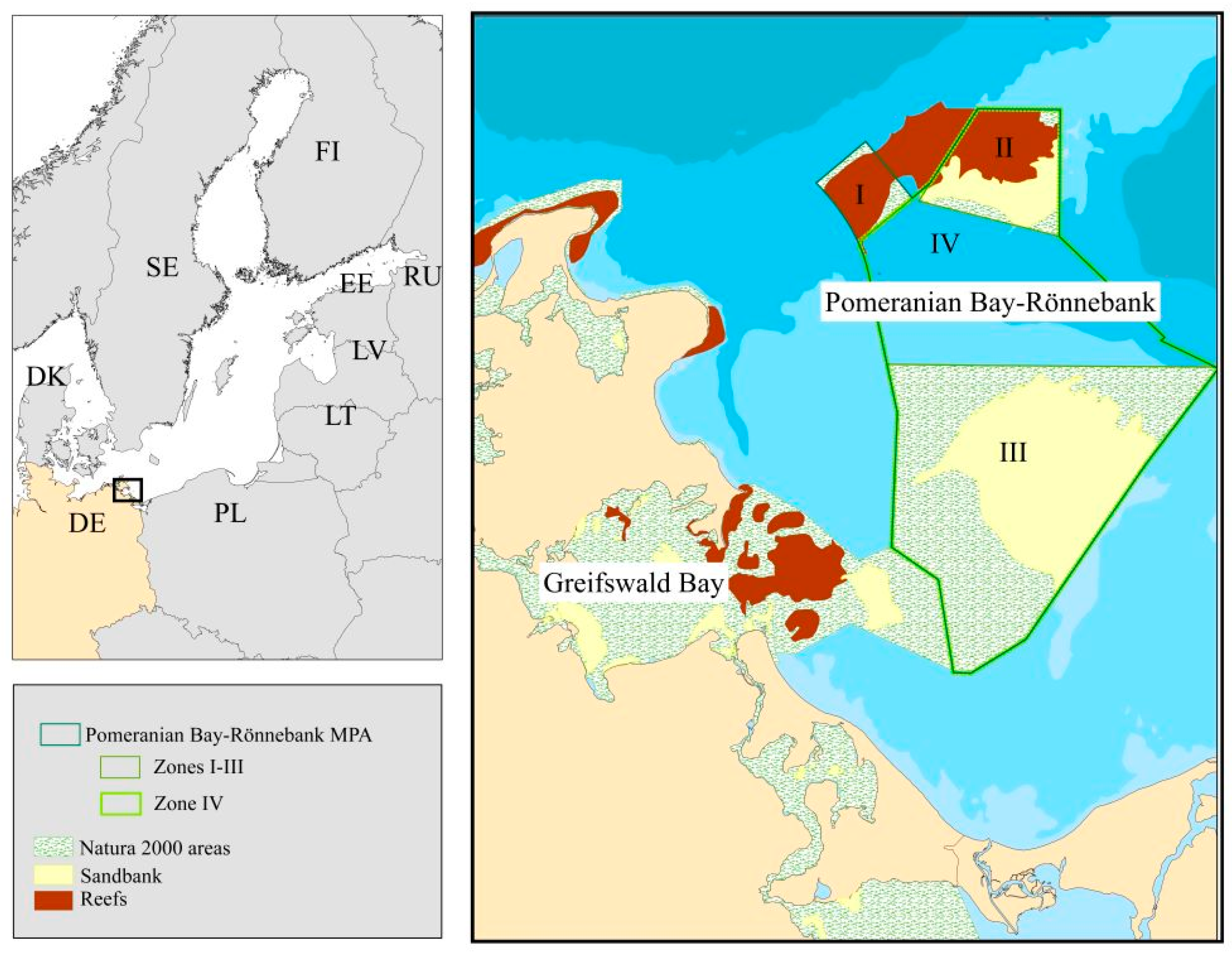
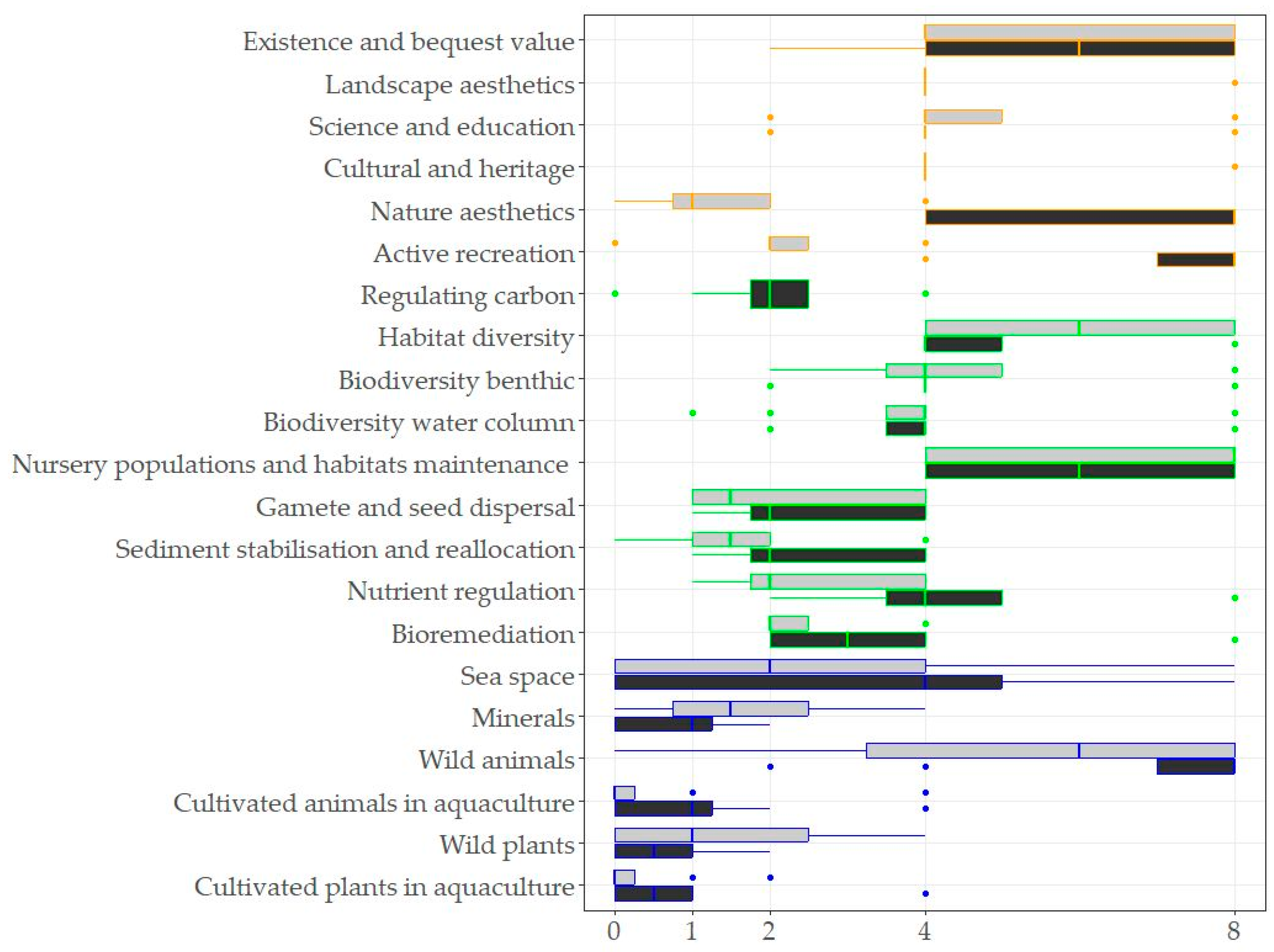
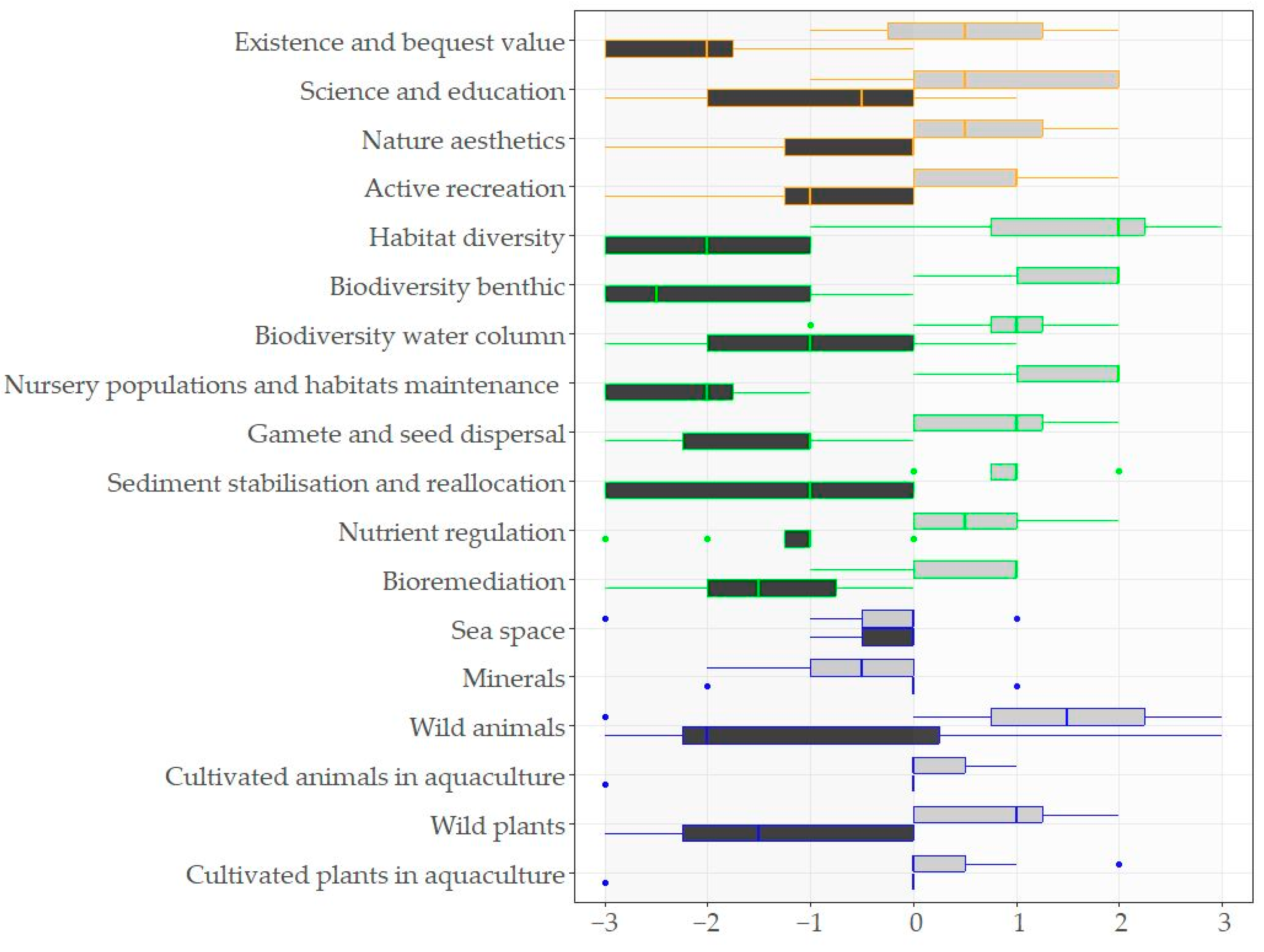
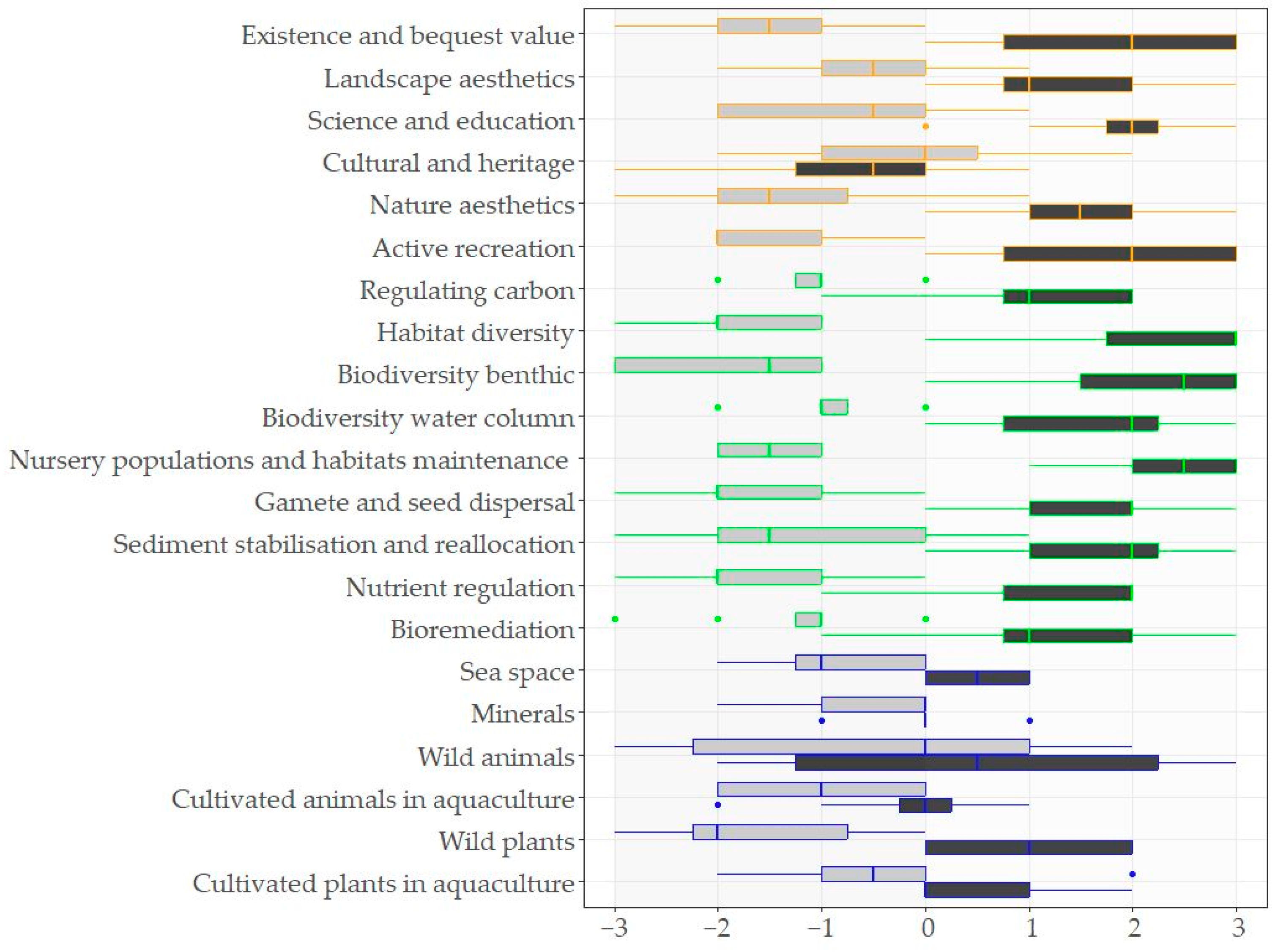
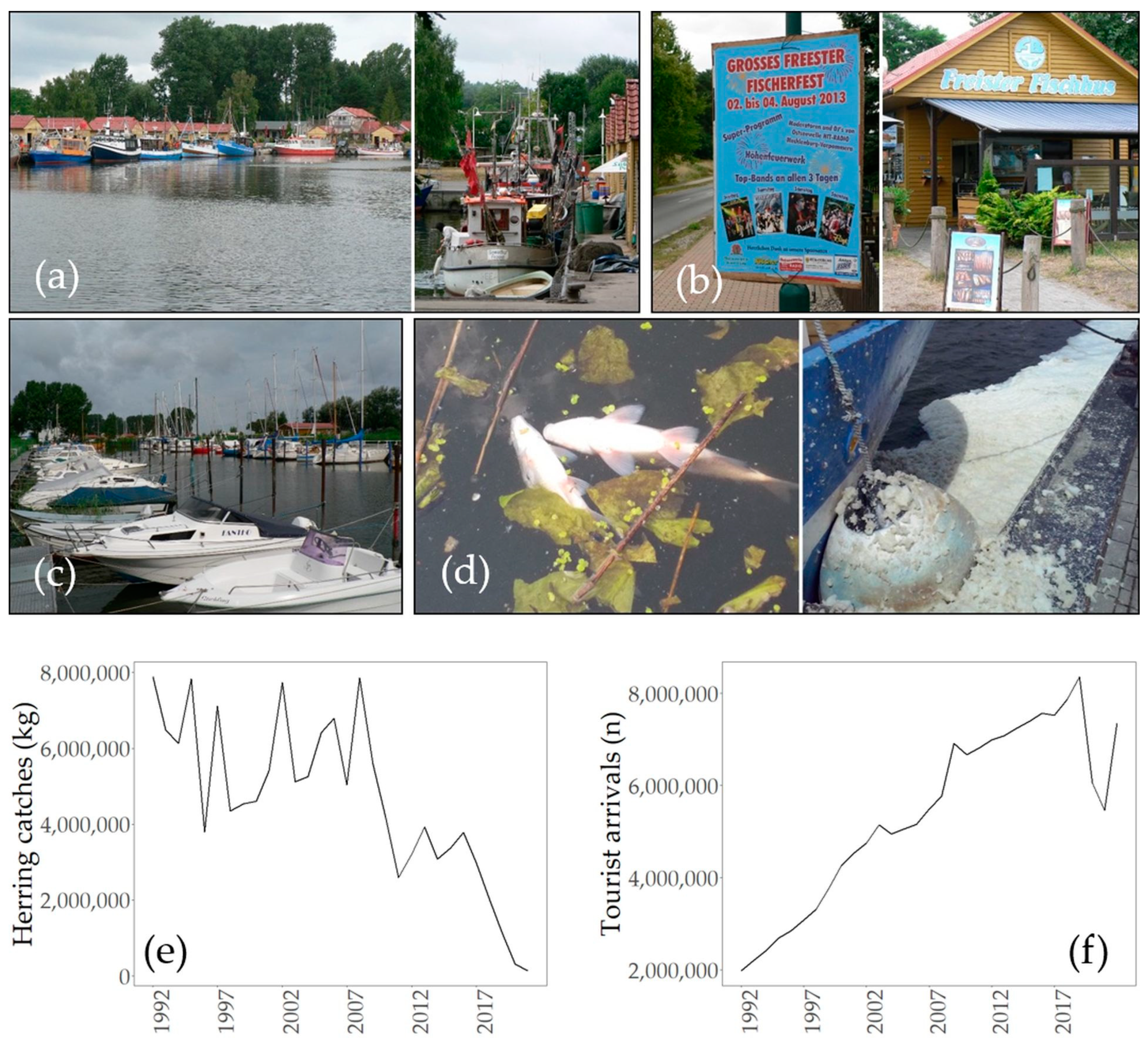
| Ecosystem Service | Description | |
|---|---|---|
| Provisioning service | Cultivated plants in aquaculture | Algae for food supply; seaweed as an insulating material, for cosmetics, as a source of energy (biogas powerplant) |
| Wild plants | Benthic macroalgae and macrophytes harvested in the shallow sublittoral and littoral zone; macroalgae used for thickening agents, agar, and superconductor electrodes, in cosmetics; algae for energy production | |
| Cultivated animals in aquaculture | Seafood (mussels, fish); biogas from aquaculture waste | |
| Wild animals | Seafood (mussels, fish); zooplankton—jellyfish used to produce collagen for various purposes (materials, medicinal, biochemical, and genetic resources) | |
| Minerals | Sand extraction or nutrients, e.g., used for agriculture | |
| Sea space | Usable area for energy conversion (e.g., solar power, wind power, waterpower); use of water by commercial ships (e.g., cargo, gas, ferries); provision of space for construction (e.g., fairways) | |
| Regulating and Maintenance service | Bioremediation | Detoxification of contaminants in soil and water; fixation by micro-organisms, plants, and animals |
| Nutrient regulation | Denitrification; storage and fixation of nutrients | |
| Sediment stabilization and reallocation | Control of erosion; sediment displacement | |
| Gamete and seed dispersal | Self-regeneration of plants after disturbance by, e.g., bottom trawling; for the restoration of, for example, seagrass beds | |
| Nursery populations and habitats maintenance | Providing habitats for wild plants and animals that can be useful to us (nursery for several fish species, feeding and wintering area for sea birds and endangered sea mammals), including gene pool protection | |
| Biodiversity water column | Animals and plants biodiversity as benefit for humans | |
| Biodiversity benthic | Animals and plants biodiversity as benefit for humans | |
| Habitat diversity | Provision of suitable habitats for different species, for functional groups of species and for processes (abiotic and biotic parameters) | |
| Regulating carbon | Regulation of chemical composition of atmosphere and oceans by sequestration of carbon (climate regulation) | |
| Cultural services | Active recreation | Using the environment for sport and recreation, e.g., diving, fishing, boat trips, sailing |
| Nature aesthetics | Observational interactions with nature, e.g., wildlife watching (birds, seals, harbor porpoise); enjoyment of landscape | |
| Cultural and heritage | Things in the ecosystem that help people to understand the history or culture of where they live or come from, such as a historic village or city, a traditional fishing ground, history of sailors, or finding historic items that contribute to cultural heritage | |
| Science and education | Site of special scientific interest (Natura 2000) and for educational purposes | |
| Landscape aesthetics | The inherent beauty of nature | |
| Existence and bequest value | Value of nature as something to preserve for itself (species, habitats) and for future generations to enjoy |
Disclaimer/Publisher’s Note: The statements, opinions and data contained in all publications are solely those of the individual author(s) and contributor(s) and not of MDPI and/or the editor(s). MDPI and/or the editor(s) disclaim responsibility for any injury to people or property resulting from any ideas, methods, instructions or products referred to in the content. |
© 2023 by the authors. Licensee MDPI, Basel, Switzerland. This article is an open access article distributed under the terms and conditions of the Creative Commons Attribution (CC BY) license (https://creativecommons.org/licenses/by/4.0/).
Share and Cite
von Thenen, M.; Effelsberg, N.; Weber, L.; Schernewski, G. Perspectives and Scenarios for Coastal Fisheries in a Social-Ecological Context: An Ecosystem Service Assessment Approach in the German Baltic Sea. Sustainability 2023, 15, 15732. https://doi.org/10.3390/su152215732
von Thenen M, Effelsberg N, Weber L, Schernewski G. Perspectives and Scenarios for Coastal Fisheries in a Social-Ecological Context: An Ecosystem Service Assessment Approach in the German Baltic Sea. Sustainability. 2023; 15(22):15732. https://doi.org/10.3390/su152215732
Chicago/Turabian Stylevon Thenen, Miriam, Nina Effelsberg, Lars Weber, and Gerald Schernewski. 2023. "Perspectives and Scenarios for Coastal Fisheries in a Social-Ecological Context: An Ecosystem Service Assessment Approach in the German Baltic Sea" Sustainability 15, no. 22: 15732. https://doi.org/10.3390/su152215732
APA Stylevon Thenen, M., Effelsberg, N., Weber, L., & Schernewski, G. (2023). Perspectives and Scenarios for Coastal Fisheries in a Social-Ecological Context: An Ecosystem Service Assessment Approach in the German Baltic Sea. Sustainability, 15(22), 15732. https://doi.org/10.3390/su152215732







